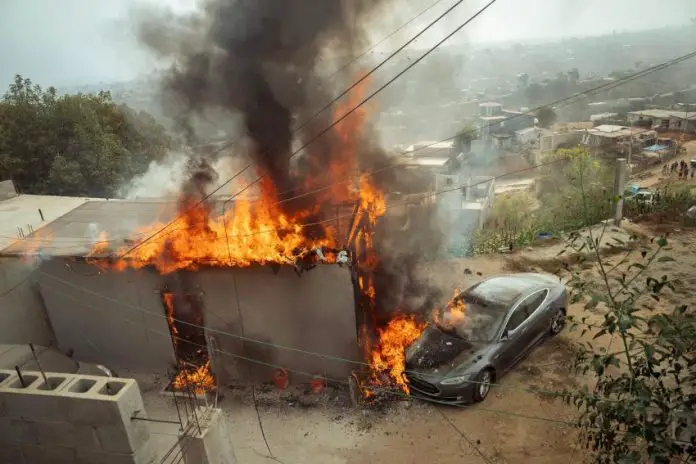Word to the wise: after spending US $70,000 or more to buy a new Tesla Model S, don’t hook it up to an electricity pole in Tijuana to charge it.
That’s exactly what someone did this week, causing a fire Monday morning in the Baja California residential neighborhood that torched an adjacent house and severely damaged the performance-oriented electric vehicle.
There were no injuries, according to officials.
“This is something unusual that we are experiencing for the first time — seeing a Tesla on fire,” said Arturo Sánchez, a coordinator of the Tijuana Fire Department that responded to the blaze.
Social media users were a little less diplomatic about the illegal hookup that caused the fire.
“And what was a Tesla doing in that unpaved neighborhood?” wrote one person. Another said that an illegal hookup to power “Señora Pelo’s little stand with a light bulb and two fryers” is one thing; trying to charge a Tesla is another.
According to preliminary reports from the fire department, the vehicle was stealing power from a public power pole by using an unauthorized and risky connection — known in Mexico by the slang name diablito, or little devil.

Frequently used at construction sites in Mexico before the Federal Electricity Commission has given a building zone power lines and by individuals seeking to avoid electricity bills, a diablito can lead to overloaded circuits, dangerous connections, fires and even electrocution.
In 2021, the federal government estimated that the Federal Electricity Commission loses 50 billion pesos (US $2.5 billion) a year to electricity theft.
According to most media reports, the incident occurred in Tijuana’s Lázaro Cárdenas neighborhood, close to the border between Mexico and the United States, although at least one report placed it near Lázaro Cárdenas Avenue, which is further south in the city.
Sánchez said a fire in a Tesla or any electric vehicle can be extremely challenging for firefighters for two reasons: A large amount of water is needed to extinguish the flames in a car laden with batteries that store power. Plus, in this case, the car was directly connected to high-voltage electricity.
The firefighter noted that his department has been offering training on how to fight fires in such vehicles. Nowadays, he said, “It is essential to know how.”
Sánchez noted that the house that caught fire was uninhabited and that the fire was contained quickly to prevent spreading to other homes. No fatalities or injuries were reported.
It was unknown if the car was a total loss, but it is certain that it was severely damaged.
Several news outlets reported the Tesla belonging to an American tourist, and one, the newspaper La Jornada, wondered why he or she made the illegal hookup “since in Tijuana there are charging stations for electric vehicles.”
Tesla has been in the Mexican news often in recent months, mainly due to CEO Elon Musk announcing it has “paused” its gigafactory project in Nuevo León, but also due to viral photos of a Tesla Model 3 being crushed by a huge, stone-carved Olmec head (not really).
With reports from El Universal, Infobae and La Jornada
